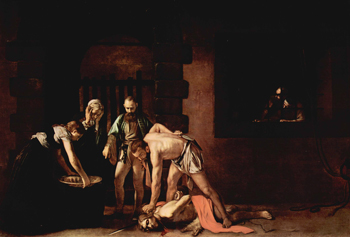
The Decapitation of Saint John the Baptist

|
The Decapitation of Saint John the Baptist
Many art critics and historians agree that ‘The Decapitation of Saint John the Baptist’ is Michelangelo Caravaggio’s largest and greatest masterpiece. The painting, which was commissioned by the Knights of Malta as an altar piece, was completed in 1608 and remains in the St. John’s Co-Cathedral to this day. It is the only work by Caravaggio to bear his signature, “f Michelang.o”, with the “f” possibly referring to his brief brotherhood within the Order of the Knights.
Within the dark setting of the 16th century prison building, St. John lays dead on the ground following his execution. The man who has slain him still holds the head while reaching for his dagger to complete the decapitation. In the background, two men are at the window watching the event, realistically typifying our own curiosity. Three figures to the left stand in audience to the slaying: Salome, who holds the gold platter, ready to receive the decapitated head, an older woman (whom some believe to be Salome’s mother Herodias) who holds her head in anguish and horror at the act of violence, and a man, feasibly the jailor, who points to the platter, giving direction to the executioner.
Caravaggio creates a perfect balance in the composition, from the group of figures on the left to the two witnesses at the window on the right. He also manages to add an element of intimacy, despite the canvas’s large size. His typical use of dark shadows and shafts of light enhances the scene’s intense, silent drama.
Restoration
Throughout the years, ‘The Decapitation of Saint John the Baptist’ suffered significant damage. In the 1950’s, the painting underwent some repairs before being displayed in a Roman exhibition. During the restoration, Michelangelo Caravaggio’s signature, crusted in blood, was revealed, making it visible to viewers. It was reconditioned again in Florence, Italy, in the 1990’s.
About the Artist
Michelangelo Merisi (or Amerighi) Caravaggio was trained as a painter in Milan under Simone Peterzano. When the artist moved to Rome, his stylistic tenebrism soon became popular, and he would receive many commissions. However, his volatile character left much to be desired; he was involved in countless arguments and physical altercations leading him to spend time in jail. In 1606, after killing a young man during a fight, the Pope issued a death warrant against him and so he fled Rome.
After spending some time in Sicily, Caravaggio went to Malta in hopes of receiving a pardon through Alof de Wignacourt, Grand Master of the Knights. Wignacourt, impressed by the artist’s exceptional talent, decided to induct Caravaggio as a knight, and made him the official painter for the Order. However, by late August of 1608, the artist returned to his “old ways” and was once again arrested and jailed. He later escaped and was subsequently expelled from the Order. Caravaggio reportedly died from a fever in 1610, his body never to be found.
‘The Decapitation of Saint John the Baptist’ is displayed in the Oratorio di San Giovanni Battista dei Cavalieri in Valletta, Malta, the church for which it was originally painted.












